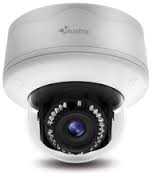Five things to consider when buying a low-light camera, by Tyco Security Products. See the annual camera-dome supplement that’s free with the September 2016 issue of Professional Security magazine. Pictured; an Illustra dome.
Thanks to the introduction of high-powered processors, better optics, improved algorithms and advanced sensors, many surveillance cameras built for low-light performance can deliver usable and high quality images. In a market filled with numerous low light cameras, selecting the right system can be more of a challenge than ever. So how can an installer more easily differentiate between the features and capabilities when selecting a low-light camera?
Maintain colour imaging
When selecting a low-light camera, it is important to know the operational requirements of that particular camera. If the customer needs to be able to clearly identify a suspect in the event of an incident, or the colour of a vehicle used in a crime, then it is also important to select a camera that can maintain an acceptable colour image in low light, as not every camera is capable of this functionality. Another consideration when comparing low light technologies is how long the camera maintains clear colour video. IP cameras will react at different light levels and also recover and settle at different places while the camera tries to recover a proper exposure level. If not implemented properly, users can lose video for five to ten seconds. Recent improvements with CMOS (complementary metal oxide silicon) image sensors have also advanced low light video quality. Some CMOS imagers are capable of maintaining colour images at levels below 1 lux.
Noise
With all optimisations in low light performance come sacrifices. Often users will find more noise and distortions present in low light images, which will reduce the quality of the image produced. Noise occurs in dark environments where video sensors struggle to capture details. Automatic gain control (AGC), where the camera automatically boosts the image received so that objects can be seen more clearly, strengthens the signal to the camera to deliver a quality image. This typically increases the noise and overall size of the video. The effect of inefficient noise reduction is not only that picture quality is low, but that noise in the picture increases the size of the image files and consequently the amount of storage and bandwidth required and those associated costs. Many cameras include an Infrared Illuminator, which makes it possible to produce an image in a low light setting. Once a camera goes into infrared imaging mode, then the camera can no longer see in colour and switches automatically to monochrome. This is ideal for applications where permanent colour pictures is not a necessity.
True Day-Night
When determining low light performance; the true day/night capabilities of the camera must be considered. Many of today’s security camera sensors are sensitive to both visible light, essentially what the human eye can see, and near infrared light, which is emitted from sources such as sunlight, moonlight, halogen fixtures, etc. True day/night delivers clearer images, dramatically improving the camera’s low light operation. This is achieved by using an IR cut filter mechanism (IRC), which removes the infrared filter from the imager to give the camera the ability to view near infrared light. Keep in mind if a camera is soft day/night, the camera will transition to monochrome video, as it will not have a mechanism in place to remove the IRC.
Shutter speed
Along with noise, a reduction in light can slow shutter speed, as an example reducing to 1/30 sec from 1/5 sec. This can cause blurring motions in scenes making identifying objects and people difficult. Shutter speeds slower than 1/3 or 1/4 sec start can be problematic due to the resulting image blur. Even at 1/2 sec, a person can run through an area and not even be seen.
Low light considerations
To test low light effectiveness, integrators and users will often perform a head-to-head shoot out in scenes below 1 lux. On paper, many cameras with a certain published lux level can look the same. However, it is not until the integrator runs a test that he can truly tell if a camera at a certain lux level produces so much noise that a person’s face becomes blurry and the bandwidth consumption has quadrupled.
Illustra UltraVision low light technology from Tyco Security Products highlights the Illustra Pro 2MP mini-domes ability for performance at a new level in the most difficult light conditions. UltraVision on the Illustra Pro 2MP mini-dome allows the camera to effectively capture high quality colour video quality in the darkest environments. The Illustra 2MP mini-dome will maintain colour video well below 1 lux.
Camera shoot-outs should be the norm for end-users and integrators who are concerned about image quality in any conditions, and this is especially true for low-light applications. With low light technologies like UltraVision, IP cameras can provide more colour video detail for users to identify people and objects of interest in dark areas more quickly, making exceptional video quality in low light situations now a reality.










